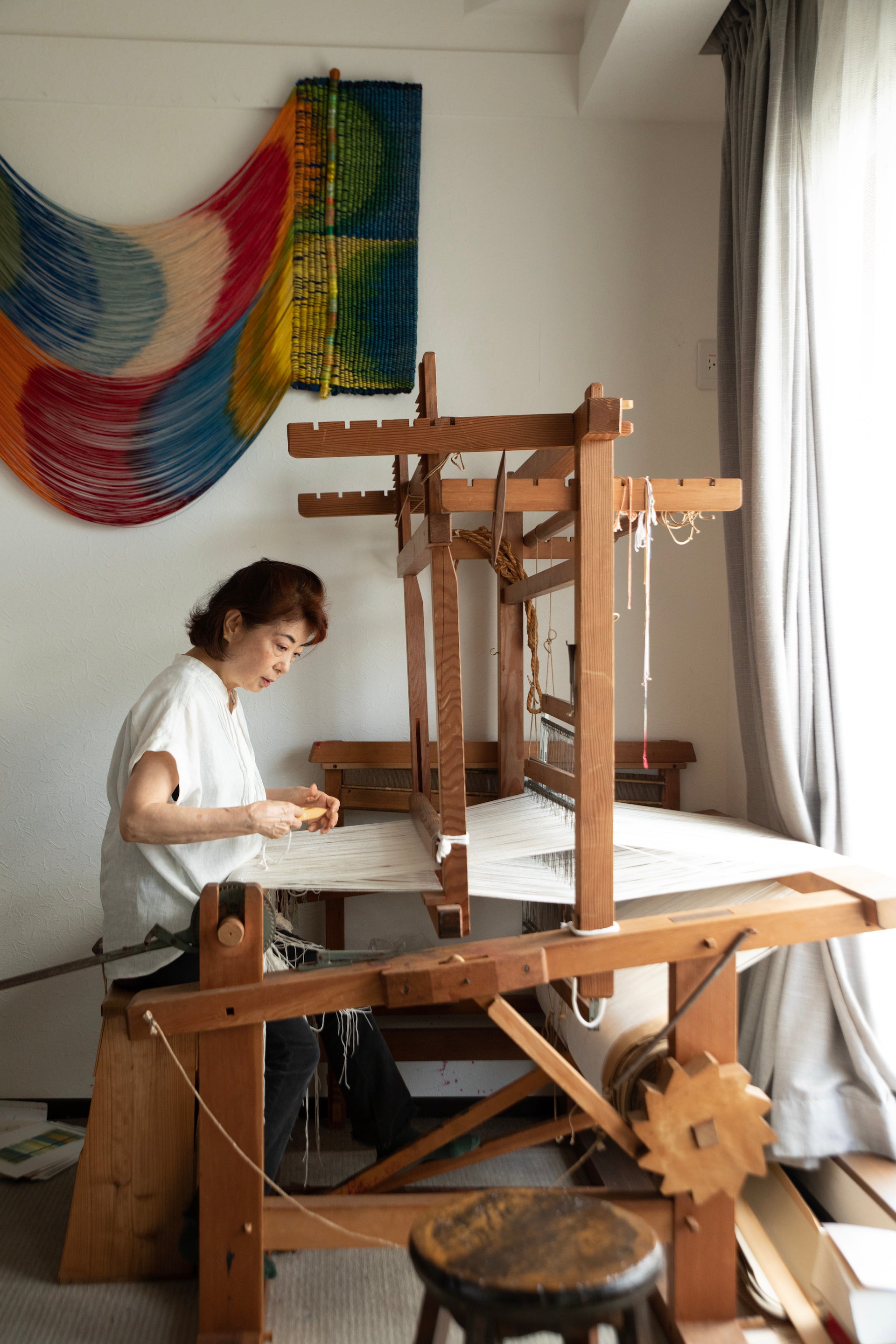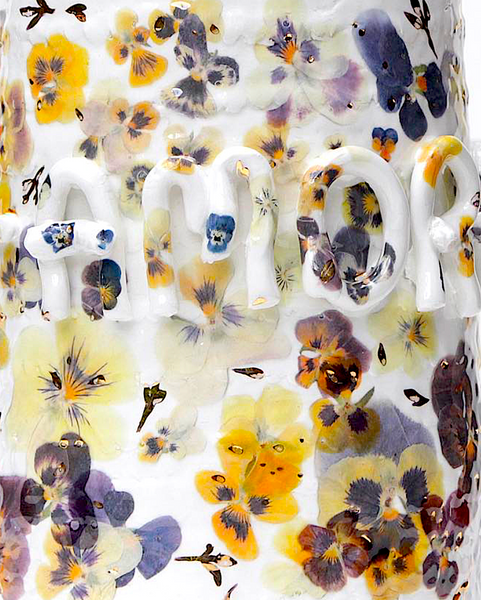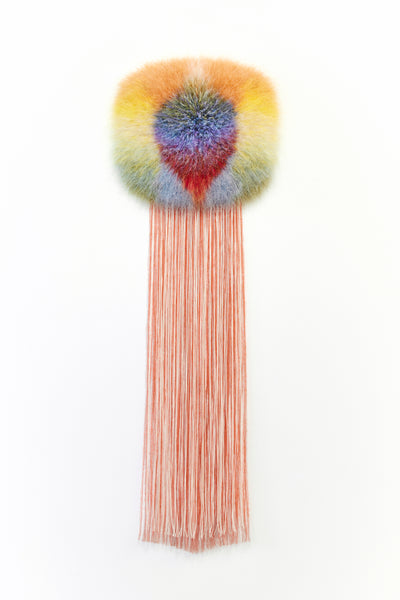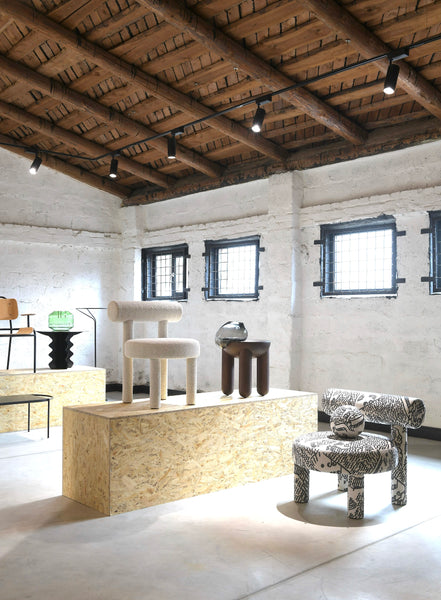How to Make It
Celebrating Kogei
Daniella Ohad’s journey into the extraordinary contemporary arts and crafts of Japan, Part III
In this editorial series, I’ve enjoyed recounting my recent journey of discovery in Japan and my encounters with some of the finest kogei artists practicing today. In Part I and Part II of the series, I highlighted masters working in bamboo and clay respectively. In this final chapter, you’ll meet five more masters, each dedicated to a different medium.
Like the others previously discussed, these artists have excelled in pushing their chosen craft to new heights of artistic expression, preserving their national heritage while also advancing the global design conversation. They’ve studied and perfected traditions in order to innovate techniques and conceptual approaches that ensure their age-old medium remains dynamic, alive for 21st-century audiences, and thriving indefinitely going forward.
Tanaka Nobuyuki (b. Tokyo, 1959) — Lacquer

For centuries, the capital of Japanese lacquer production has been Kanazawa, where the medium first emerged as a protective coating for samurai armor and later blossomed in the creation of highly refined teaware, vessels, and food utensils. Today, Kanazawa is home to Tanaka Nobuyuki, the region’s foremost lacquer artist, widely lauded for channeling the traditional craft into abstract sculpture.
In Tanaka’s hands, lacquer finds its most lyrical expression, capable of communicating his reflections on nature, society, and changing contemporary values while also physically engaging the surrounding space in the most intriguing ways. It’s no wonder that his work is found in prestigious collections around the world, including New York’s Metropolitan Museum of Art and London’s Victoria & Albert Museum.

Tanaka fell in love with lacquer, its long history and connection with Japanese identity, as a student at Tokyo University of the Arts. At the time, he did not yet foresee the prestigious career that lay ahead. But once he dedicated himself to the medium years later—when at age 40 he moved to Kanazawa—he knew right away that he wanted to push the medium in new directions and explore its sculptural potential.
Tanaka’s quiet studio is filled with antique lacquer vessels and a wealth of tools and materials required for his practice. Photographs of rivers, waterfalls, and mountains line the walls and serve as vital sources of inspiration. This environment, he feels, connects him to the legacy of the region, which is rich in natural beauty, picturesque villages, and the country’s best lacquerware workshops.

Tanaka recognizes that his knowledge of and appreciation for this legacy has enabled him to successfully depart from tradition and forge a new path. For his students at Kanazawa College of Art, he emphasizes the importance of preserving the craft by making it relevant to the present. “Without new means of creation,” he told me, “lacquer will become extinct.” He believes that this is an exciting time for lacquer art, a new era of diverse and innovative expressions.
Tanaka’s distinctive large-scale sculptures capture the spirit of the local landscape through minimalist, abstract, and meticulously crafted forms. Among his many innovations, these forms begin as carved blocks of Styrofoam, rather than traditional wood and leather substrates. His red or black lacquered surfaces are sleek and high-gloss—a magical effect achieved thanks to his own labor intensive process. After the multilayer application of sap gathered from the region's enormous Toxicodendron trees, the Styrofoam structure is removed, leaving behind sculptures of pure lacquer. Even with the help of five studio assistants, each takes five to six months to complete.
Hara Satoshi (b. Yokohama, 1962) — Metal

Exquisite vessels crafted in iron and copper, speckled with glittering inlaid silver, gold, and platinum in patterns inspired by natural phenomena—intricate spider webs, seashells washed up on the shore, and bright stars in a crisp night sky. This is the uncanny oeuvre of metalwork artist Hara Satoshi.
Visiting Hara’s studio at the Kanazawa College of Art—where he serves as a professor for metal art—was a memorable experience, because it revealed the way in which he has brought new life to an ancient craft by injecting it with contemporary, poetic narratives that transform base metals into artworks that are beyond precious.

Hara was born and raised in the city of Yokohama, in a district surrounded by serene pine trees and ponds. He clearly remembers how watching the industrious, skilled hands of his craftsman father made him dream of working with his own hands. He was introduced to metalwork as a student at Tokyo University of the Fine Arts and instantly fell in love. He was fascinated by metal’s dual nature, simultaneously industrial and modern as well as ancient and artistic.
The technical challenges of working with metal never daunted Hara. During my visit, he explained that metal art is “one of the most respectable craft fields in Japan,” and as such calls out to be explored and preserved. It is an expression, he added, of wabi-sabi culture, the Japanese philosophy of embracing nature’s transience and imperfections. “We are surrounded by water and volcanoes,” he told me, “and therefore metals are susceptible to oxidation and sulfidation, to discoloration and deterioration due to rust. We have to accept those climatic conditions and their effect on metals.”

Hara is known especially for multi-alloy vessels that exploit a range of metalwork techniques, including chasing, engraving, embossing, inlaying, and nanako-uchi (fish-roe engraving). The latter was historically used in the production of weapons for the aristocracy, utensils for Buddhist rituals, and architectural ornaments for shrines and temples. But Hara adapted it to the curved surfaces of his vessels, creating networks of textures that appear to move as the ambient light or angle of viewing changes. These patterns, for Hara, are not merely decorative, but rather express the profound nature of the world.
For Hara, artistic expression rests on three, balanced foundations: thematics, creativity, and quality. He explained that creativity entails a departure from conventions, but quality arises from the dignity and honesty of the craftsmanship, which is dependent on the maker's skills and experience. As a teacher at the Kanazawa College of Art, he is committed to instilling knowledge of historical techniques and respect for heritage, while also inspiring his students to find their own voice. He encourages them to express their emotions, imaginations, and personal narratives in response to our ever-changing zeitgeist—just as he does in his own work.
Sako Ryuhei (b. Tamano City, 1976) — Metal

Inspired by nature and traditional Japanese metalsmith techniques, Sako Ryuhei creates the most exquisite vessels. The metal artist practices his craft in his home-studio outside of Okayama City, amid a serene landscape of mulberry trees and the delicate flower garden he meticulously cultivates. He was born and raised nearby. With the exception of the years he spent studying metalwork at Hiroshima City University, he has lived in the area his entire life. “As my job makes a lot of noise,” he told me, “I looked for a secluded place in the countryside.”

Sako is among only a handful of contemporary metal artists practicing the unique hammering technique known as Makume-gane, which dates to the 17th century and results in surfaces reminiscent of natural wood grains. He chose this practice at age 20, when he saw for the first time the work of Tamagawa Norio (b. 1942), Living National Treasure of Mokume-gane, at the Japan Traditional Art & Crafts Exhibition. Upon graduation, Sako became Tamagawa’s apprentice.

Historically, Makume-gane was used to craft swords, particularly status-symbol weapons. Today, Sake sees Makume-gane as a dynamic process for producing decorative vases, bowls, tea caddies, and more. His studio is filled with hundreds of tools, all polished and arranged meticulously according to size and function—and he uses them all. He keeps his workshop very orderly, because it is the only way he can focus on the intricacies of his work.
Sako’s home studio blends his private and professional life. A showroom and reception room about his workshop. His wife, a glass jewelry artist, has her own workshop onsite as well. The couple take turns caring for their young daughter.

During my visit, Sako treated me to a full demonstration of his highly skilled, labor-intensive practice. He laminates thin sheets of base metal alloys in various colors—silver, copper, black copper, shakudo, shibuichi—stacked like a sandwich and then bonded into one mass. Each of the resulting three-inch-square cubes becomes a precious, new vessel through months of hammering, carving, and heating. It’s clear that Sako enjoys his work.

Sako’s light, airy vessels—the product of his exceptional mastery of the centuries-old Makume-gane technique—earned him a LOEWE Craft Prize and membership in the Japan Kōgei Association.
Senda Takanori (b. Kakamigahara, 1983) — Washi Paper

Only two natural ingredients are needed to make the world’s finest handmade paper: clean river water and branches from the kozo tree, part of the mulberry family. In Japan, washi—as this labor-intensive, artisanal paper is called—has played a central role in the national identity, used in the creation of an array of everyday objects, including shoji screens, lanterns, fans, umbrellas, and more, for time immemorial.
My search for Japan’s best contemporary washi paper led me to the studio of Senda Takanori, whose small workshop on the outskirts of Mino City has become a pilgrimage destination for paper artists from all over the globe, all hoping to learn from this outstanding, innovative, and influential washi paper master.
For more than 1,300 years, the finest washi—silky, sensual, translucent, and white—has been produced in Mino City, aided by the pristine waters (especially in the winter months) of the nearby Nagara and Itadori Rivers. The ancient town’s washi paper production was added to the UNESCO Intangible Cultural Heritage list in 2014. Twenty washi paper studios are currently active today.

Populated with wood buildings from the Edo period (1603-1868), Mino City is known for “Mino shi,” a particularly white washi paper sought after today for use in important temple restorations, exquisite new architectural constructions, and museum-quality design objects. It is made through a meticulous process that begins with harvesting, cleaning, and boiling kozo tree branches in pure river water. The pulp is mixed with more river water, and then strained through mesh. The resulting thin sheets of washi paper are laid out in the sun to dry.
During my visit, as Senda demonstrated his take on the traditional Mino shi production process—incorporating tiny leaves and flowers into the pulp, drizzling paint into the slurry, and spraying it with water from tools he invented to create lovely patterns—he declared, “water is the lifeblood of paper.”
Given his expertise, I was surprised to learn that Senda did not pursue the art of washi paper until relatively recently. After graduating from Aoyama Gakuin University in Tokyo, he set off to explore the world, heading first to London, where he became interested in indigenous cultures. He went on to spend time in Peru and Bolivia. When he returned to Japan, he found himself in Mino City, immersed in washi paper heritage, which led him to take a position at the Mino Washi Museum. Soon he felt the urge to create his own washi paper and became an apprentice to master Ichihara Tatsuo.

Like many of the kogei artists spotlighted in this series, Senda deeply absorbed long-established methods before developing his own approach to his chosen medium. He came to recognize that preservation necessitates innovation. For him, making paper is not just a rote process; it’s a living art that must evolve to reflect contemporary mores.
Senda’s commitment to bringing washi heritage into the 21st century inspired him to found Warabeeland, a papermaking facility with an adjoining hotel housed in a renovated craftsman’s home. There visitors can learn about washi history and techniques—even how to grow kozo trees. He’s currently dreaming about sharing his art further afield, to audiences beyond Mino City, both in Japan and abroad.
Asakura Mitsuko (b. Kyoto, 1950) — Tapestry

To award-winning textile artist Asakura Mitsuko, tapestries are architecture. These woven textiles, she told me, are made to be an integral part of an interior, bringing a warmth, intimacy, and organic spirit that has the power to transform a cold, hard space into a welcoming home. The surrounding space defines the tapestry, and vice versa.
While tapestry production has ancient roots, Asakura’s work is wholly contemporary—unique, personal, and energetic with colorful, undulating shapes. Her process merges traditional Japanese dyeing techniques, which she learned from her father, with European weaving techniques, which she studied in both Italy and the Netherlands.

Asakura was born and raised in Kyoto and continues to call the city home. Kyoto, she told me, is “the mecca of textiles,” and she loves everything about it, from its artistic heritage to its mountainous landscape and pure water (which she uses in her dyeing process). Her hometown inspires her work, as do her fond memories of growing up in her father’s textile studio, watching him diligently at work with his apprentices dyeing textile fibers.
Another powerful set of memories has fueled Asakura’s ambition to become a weaver: her many visits to Kyoto’s annual Gion Festival, where she reveled in the parades of imposing floats designed to symbolize divine spirits and covered with intricate European tapestries. She took up loom weaving at age 16.
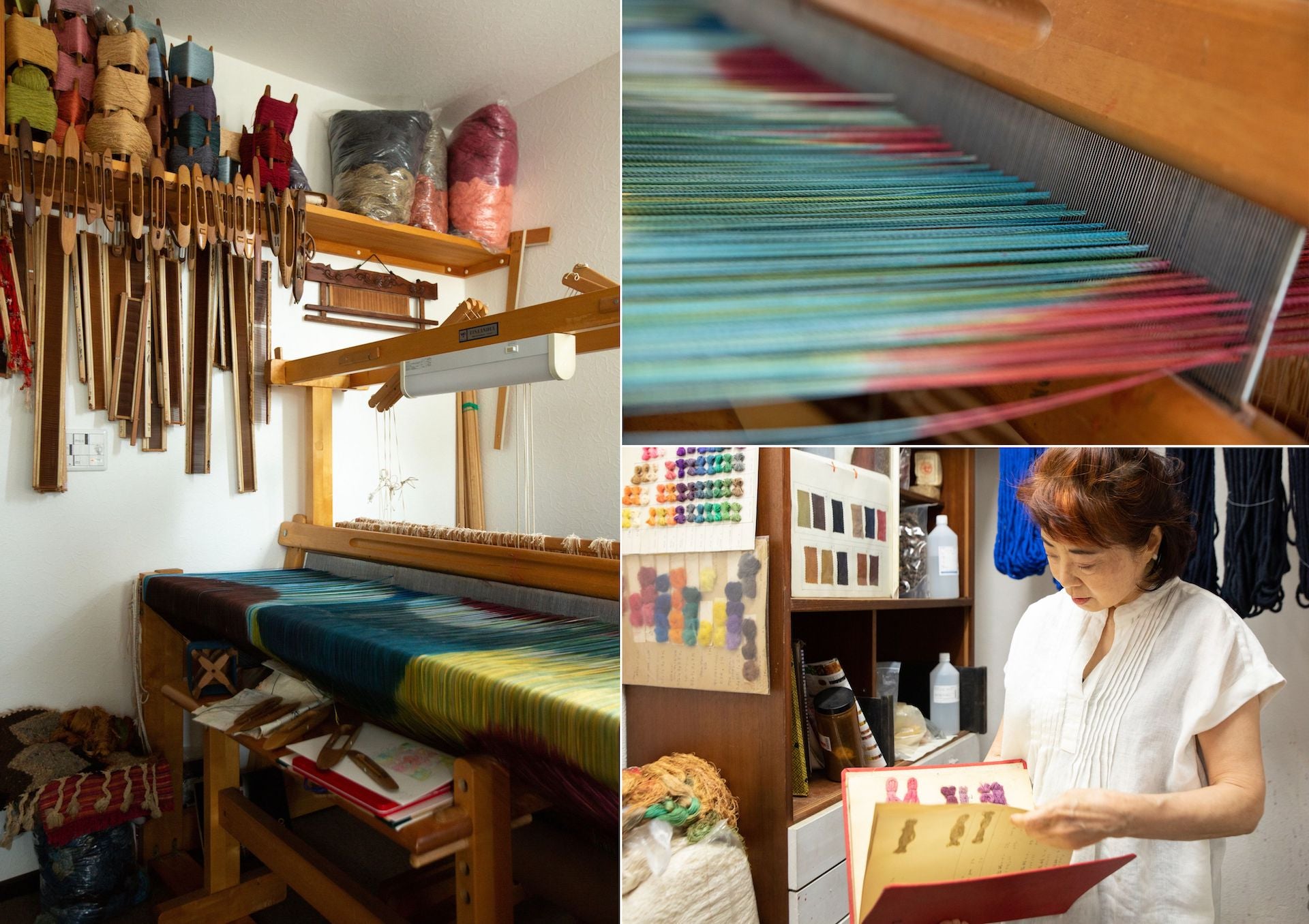
Working in her beautiful, expansive villa in the Gosho-Minami neighborhood, Asakura has been on a quest to innovate her medium. In her basement, she dyes silk with leaves, bark, wood, roots, flowers, nuts, minerals, and insects collected from the open fields around Kyoto. On the second floor, she has created a private sanctuary for weaving, full of antique and contemporary looms, a traditional spinning wheel, and vibrant boxes of yarn. The spectacular fruits of her labor are hung on walls throughout the home.
For Asakura, the act of dyeing and weaving is spiritual; she believes these processes bridge the old and the new. She sees textile art as “feminine” and tapestry making as a kind of childbirth. While spinning on the old wooden wheel, she explained that each tapestry is impacted by everything that surrounds its making: the season, temperature fluctuations, thread and dye quality. Each production brings its own conditions and challenges, so no two tapestries can be exactly alike. “I listen to the voice of the threads,” she told me, “to devise each step of the process.”

Around the turn of the millennium, Asakura first developed her iconic Waltz series. Composed of small, discrete dots of color, these novel, Pointillism-inspired tapestries feature brilliantly hued patterns that seemingly dance before your eyes.
This body of work was recently showcased at fashion designer and collector Lisa Perry’s Onna House, an art space in East Hampton dedicated to supporting women artists, designers, and makers. Perry told me she was so enthusiastic when she discovered Asakura’s tapestries that she immediately acquired a dozen examples. “Mitsuko Asakura’s use of color is extraordinary,” Perry said. “Her shapes are completely her own, and her pieces draw all the attention in any room.”
Fukumoto Shihoko (b. Shimizu, 1945) — Indigo

Fukumoto Shihoko, Japan's most celebrated indigo artist, has dedicated her life to giving “Japanese Blue” a new identity and giving vintage handmade fabrics a second life. Her pieces have many layers—both literally and figuratively.
Indigo is a product of nature, but the green leaves of the Indigofera plant obscure the deep blue dye that lies within. Introduced to Japan in the 8th century, indigo has long contributed to Japanese material culture through the embellishment of fabrics for both fashion and home decor. Fukumoto pioneered indigo as a medium for contemporary installation art. “Indigo,” she said during my visit to her studio in the Nishinokyo neighborhood of Kyoto, “has been widely used to dye kimonos and household items, but I want to turn it into an art form.”

Born in the Shizuoka prefecture and raised in Osaka, Fukumoto studied fine arts at Kyoto University. She discovered indigo by accident, while working for a textile company. From her first encounter with the alluring transparency of indigo-dyed silk threads, she foresaw the dye’s potential for spatial expression.
The beginning was not easy for this indigo innovator. In the 1980s, the medium was largely synonymous with crafted functional objects, completely unknown in fine arts, which forced her to exhibit in craft-related platforms. She was 40 when the art world finally woke up to her vision, though not yet in Japan, and her work began to show in international museums and galleries. She was 60 when her home country fully accepted her work as art, outside of a craft context.

Fukumoto’s art is layered with Japanese heritage, although the story is told in her own, intriguing voice. She applies her dyes to handmade fabrics salvaged from kimonos, uniforms, and other textile articles that she finds in second-hand stores around Japan.
Until a few decades ago, she told me, these fabrics were made by hand in natural fibers like banana and pineapple leaves; today, similar textiles are mass produced. By giving these fabrics a new life in her artwork, she hopes to honor and preserve the traditions and customs they embody. “We are living in a time of loss,” she lamented.

So much in her studio is blue, from the bags of dry indigo in the ground floor workshop, to the textiles hanging and packed in fine paper in the second floor space. The effect is uplifting and intoxicating.
When indigo is first mixed, the hue it produces is dark and saturated. But the more the mixture is used, the lighter the results—until it is thrown away and a new mixture is made.
The more you dip into the dye, Fukumoto demonstrated in her studio, the faster the saturation fades and longer it takes to achieve the deepest blue. For Fukumoto, indigo expresses a kind of traditional Japanese spirituality that transcends time and space. ◆
I would like to thank those whose efforts made this tour and published article possible: Wahei Aoyama and Kumiko Sunahara of A Lighthouse called Kanata; Takanori Senda of Warabee Paper Company; Nana Onishi of Onishi Gallery; Atsumi Fujita of Sokyo Gallery; Lisa Perry of Onna House; and the inspiring artists who opened their studios to generously share their stories.
Be sure to check out Part I and Part II of the Celebrating Kogei editorial series.
